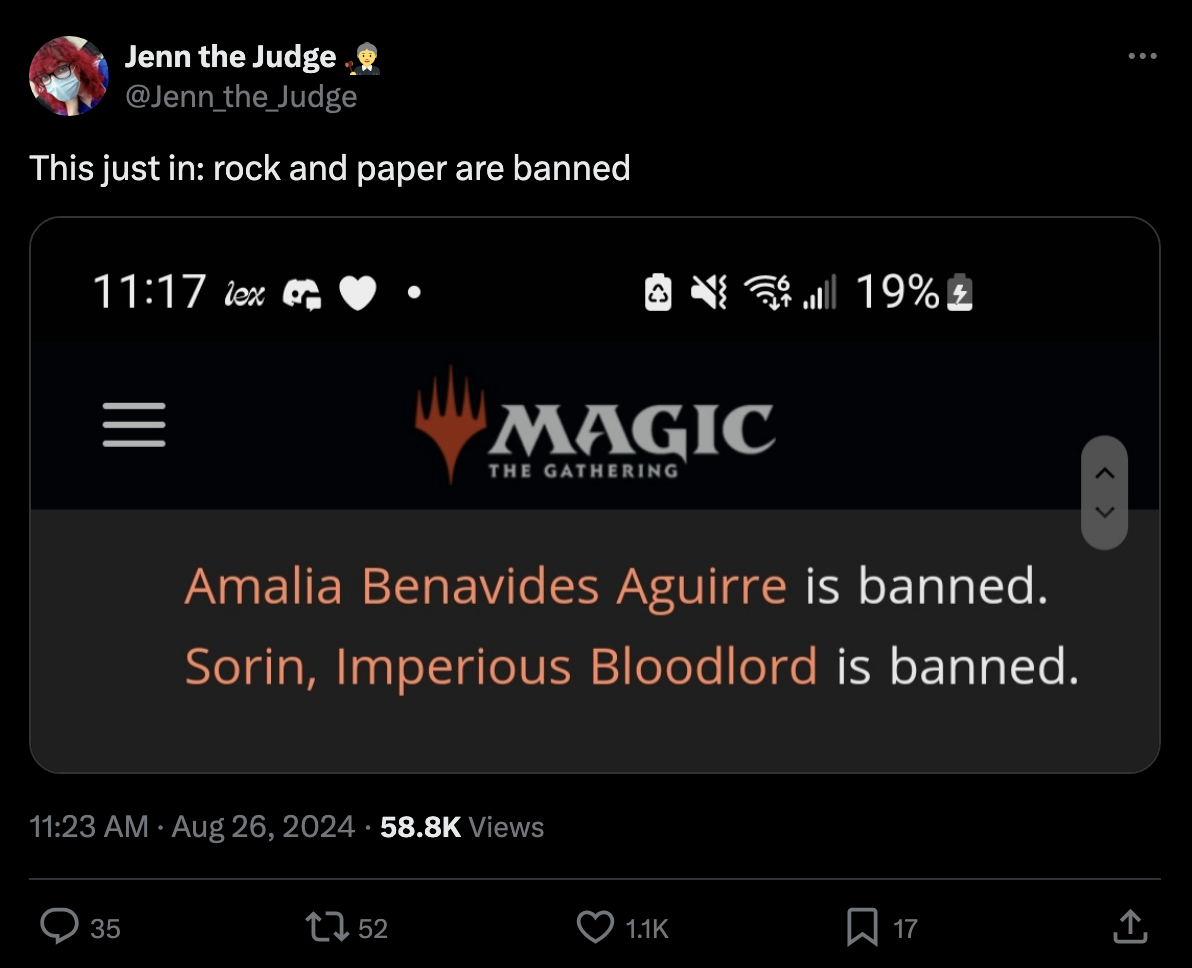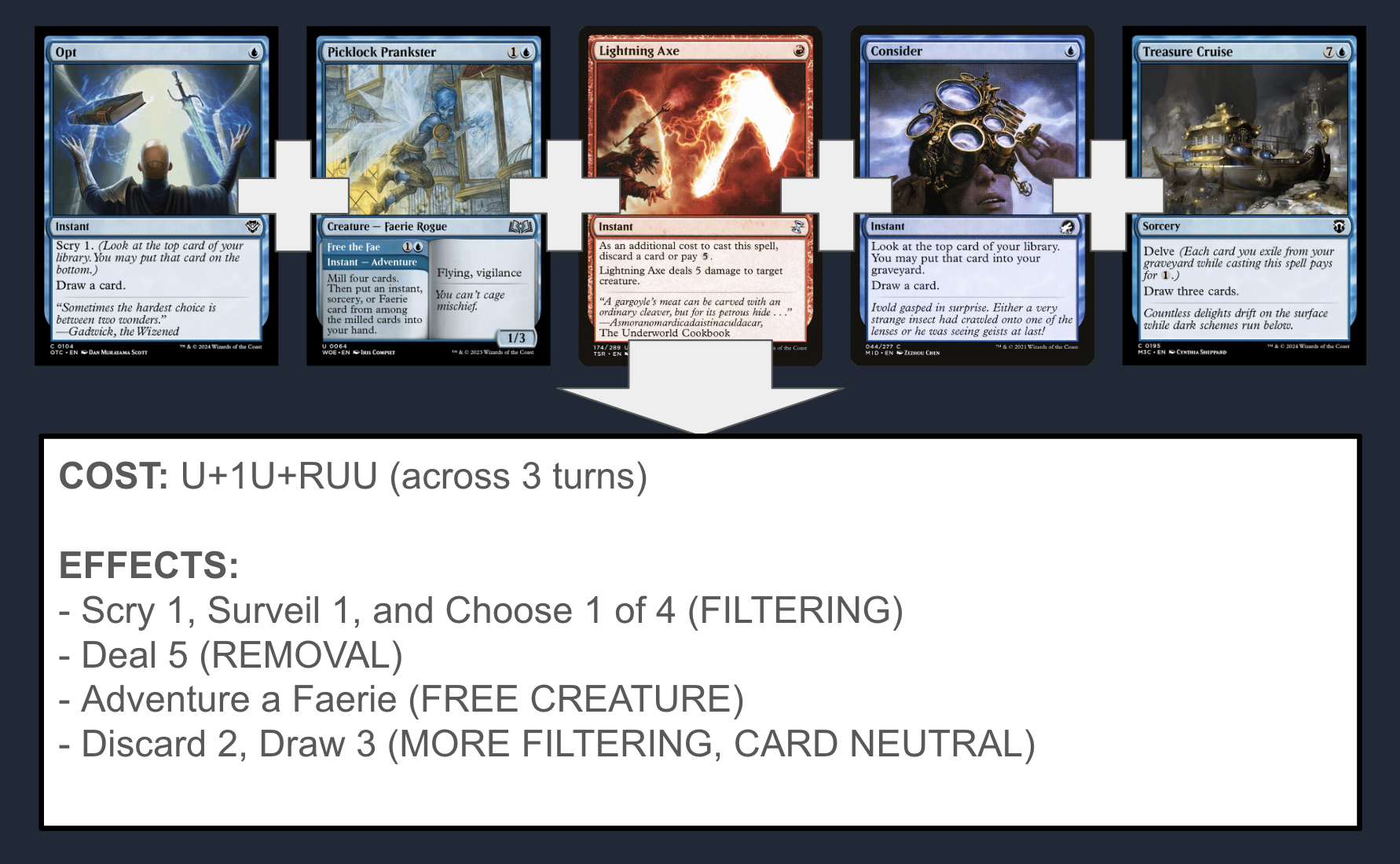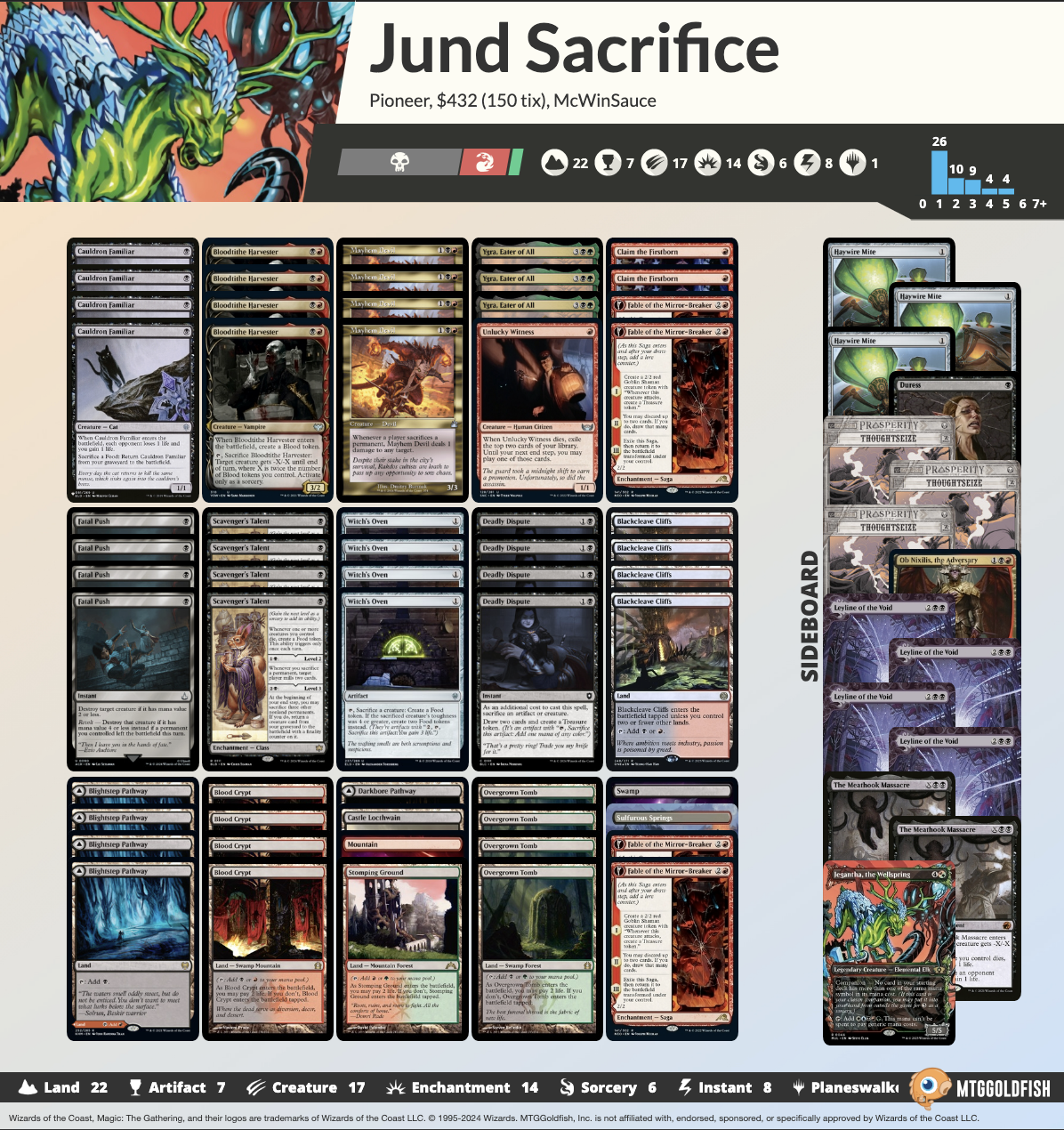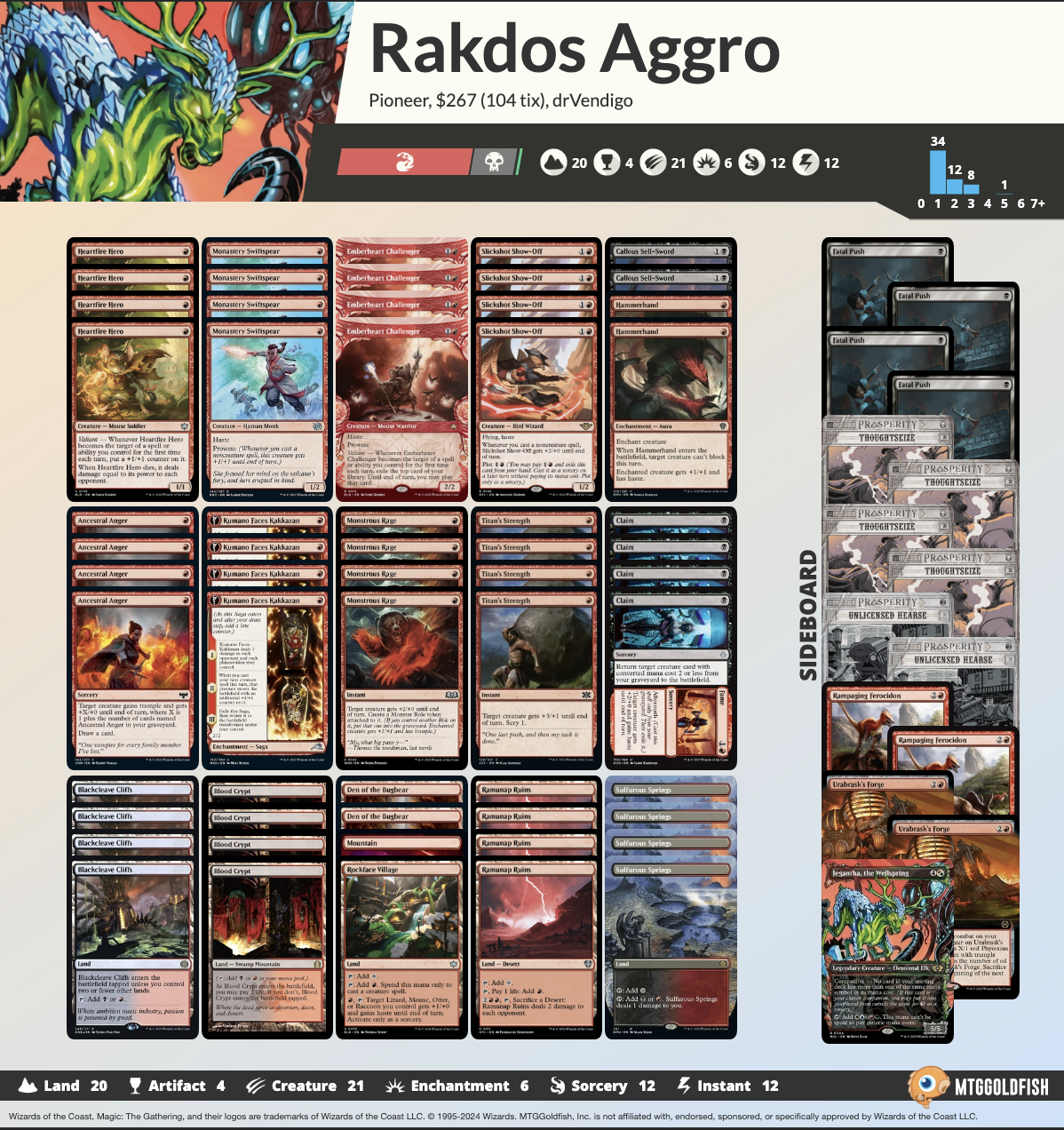How to Beat Pioneer Phoenix
09/02/2024
Following the most recent ban announcement, there was a common joke being floated around:

This just in: rock and paper are banned
Before the ban announcement, it was pretty widely known that the decks to beat in Pioneer were Rakdos Vampires, Amalia Combo, and Phoenix. Vampires was the most popular by far, but all three of these decks were in the conversation as the "big 3" decks.
And now, post-ban, three has become one.
So, the obvious question now is: is Phoenix now just the best deck in Pioneer? It was the second best widely-played deck at the last Pioneer PT, after all (only behind Rakdos Vampires, which debuted at that PT and is now of course banned).
Is there actually a way to beat Phoenix? Does it actually have any bad matchups anymore? And if you can't beat it, should you just join in the birding?
Part 1: What Makes Phoenix Tick
When trying to attack a very specific deck in the metagame, a very important step is to first understand how it works. What is its gameplan? What are its strengths and weaknesses? The best way to attack a deck is with precision strikes at where it is weakest, so first we must understand where those weaknesses are and how they manifest.
The Treasure Cruise Engine
The first card that comes to mind when most people think about Phoenix as a deck is, of course,
Treasure Cruise. Pioneer players have been calling for Treasure Cruise's ban for a very long time - after all, it's just Ancestral Recall, right? Isn't this card a power level outlier for the format?Well, kind of. Treasure Cruise is extremely powerful - of that there's no doubt. But there's also a reason why no other decks in Pioneer play Treasure Cruise, and basically no decks have played its sister card
Dig Through Time either since Inverter of Truth was banned.As it turns out, Pioneer just so happens to be in a sweet spot of formats where fueling powerful delve cards takes active effort.
That effort can very well be worth it, but it very much still exists. Treasure Cruise may feel like an Ancestral Recall in when it's resolving, but that ignores the previous very real costs of filling the graveyard. And in reality, Treasure Cruise costs something like 4-5 mana - it's just that that mana was split up across multiple turns and multiple spells, each of which also provided a benefit of its own.
In my experience, the most useful framework through which to analyze these costs, then, is to look at the total end result: if we cast
Opt on turn 1; then Picklock Prankster on turn 2; then Consider, Lightning Axe discarding a card, and a fully delved Cruise on turn 3; then the output looks like the following:
Opt, Picklock, and Consider all replace themselves as cantrips, and thus provide mostly filtering. We get a creature in adventure from Picklock, and a removal spell from Axe at the cost of two cards. But then we get to recoup those two cards with Cruise and come out even on raw cards-in-hand - except that we dealt 5 damage and drew a creature.
Framing it this way makes the output look quite good, but in a much less hyperbolic fashion than Ancestral Recall. As it turns out, spending your first three turns to do a bunch of filtering to setup your future draws, kill a creature, and draw an extra creature, all while staying even on cards in hand is a very strong rate!
And this, then also reveals the real strength of Cruise: it subsidizes the cantrip infrastructure around it, allowing you to recoup the mana cost of cantrips cast before it, and the card costs of Lightning Axe. Individually, all the other cards have flaws - small amounts of filtering is nice to have but not worth the costs in a vacuum, and Lightning Axe is a powerfully efficient removal spell but hard to sustain without a card flow engine. But Treasure Cruise enables them all, tying everything together in beautiful synergy.
Outputting Efficient Threats
The threats in Phoenix also work in a similar way, latching onto the Treasure Cruise engine in order to be taken to the heights of efficiency.
Arclight Phoenix, the namesake card of the deck, latches onto the cantrip part of the engine, and the discard outlets in the deck. When all your mana is being spent to run and derive value from the cantrip/Cruise engine, a free threat like Phoenix is just what you need to produce extra outputs from your engine at no cost.
Similarly,
Ledger Shredder fits in snuggly as a card that pays its own mana cost back with connived cards that can then be used to delve Cruise. Of course, it also synergizes nicely with cantrips providing ample double spell turns, and with Phoenix providing juicy discard targets. And on top of all of that, it also grows much quicker than it would in most decks, as the deck runs enough cantrips to heavily cut down on lands.Finally,
Proft's Eidetic Memory is a very new addition that joins together even more parts of this intricate engine, turning the "free" 1/3 bodies from Picklock Prankster into even more efficient threat output with card draw from cantrips, Cruise, and Shredder.So, in their own ways, the threats in Phoenix all serve as almost incidental outputs of the core engine of the deck. All of them work to minimize the card and mana costs of putting them into play by hoooking into the engine in various ways, letting the rest of the deck focus purely on running the Cruise engine at peak efficiency.
Part 2: The Weaknesses of an Engine
As established, we can think of the Phoenix deck as one big engine. It takes inputs of cantrips and efficient removal, and leverages Cruise to keep churning through cards and output efficient threats. So, how do we beat it?
Hating the Engine
There is, of course, the simple answer of attacking the engine itself. If you prevent Treasure Cruise from being cast, then you impact the efficiency of the entire deck.
The most obvious way to do this is with graveyard hate -
Rest in Peace, Unlicensed Hearse, Leyline of the Void, Go Blank.You can also attack the efficiency of the engine itself, by taxing it with
Thalia, Guardian of Thraben, limiting its rate with Deafening Silence, or punishing it with Magebane Lizard. But these kinds of hate pieces are generally a bit less effective, as even an inefficient engine can beat you.That said, even the hard graveyard hate pieces are nowhere near perfect. Phoenix sideboards are generally fairly prepared to restructure their deck to function through hate cards, and spending a full card on a hate piece is quite a big cost. They're a good tool for improving your postboard matchup against Phoenix, but rarely ever swing a matchup by themselves.
Efficient, But Inflexible
While it's running, the Phoenix engine is nigh-unbeatable in efficiency - in fact, I would say that this is one of the main draws of Phoenix. You just can't get a more efficient rate of generic-cost-to-effect than what Phoenix outputs from its engine, both in threats and in interaction. Every card is highly optimized for its role - Phoenix is the most efficient threat, Lightning Axe is the most efficient removal spell,
Spell Pierce is the most efficient counterspell.And this trend continues in the sideboard as well! Common inclusions include cards like
Mystical Dispute, Aether Gust, and Rending Volley. These are all silver bullets, slotting into the deck post-board as simply the most efficient answer possible for the role it's trying to fill.But all this efficiency does come at a cost: namely, some degree of inflexibility. Because Phoenix's engine takes up so much deck space to run (as many as 16 cantrips and 4 Cruises), there simply isn't that much room left in the deck. And with the focus on efficiency, much of the interaction is heavily specialized in order to maximize that efficiency. This specialization, then, can lead to some gaps in its defense.
For instance, while Lightning Axe is an extremely powerful removal spell for most creatures, it struggles to deal with 6+ toughness creatures, and cannot affect any noncreature permanents. As such, Phoenix is famously somewhat bad at interacting with artifacts and enchantments preboard.
Sideboarding can mitigate this to some extent - you'll often see
Prismari Command to deal with artifacts, and Brazen Borrower as catch-all interaction. And with all of the filtering from the cantrip-Cruise engine, Phoenix is also abnormally good at finding these sideboard silver bullet.But even still, this often leaves enough room with which to attack Phoenix. Ygra combo, for instance, is a new deck in Pioneer that leverages this to some extent.

a recent Ygra list that did well in the pioneer qualifier on MTGO
Ygra, Eater of All, as a card that starts with 6 toughness and grows whenever you target it, is extremely hard for Phoenix to remove from the battlefield. And Scavenger's Talent also dodges Phoenix's general interaction suite as an enchantment that's cheap enough to sneak in under a Spell Pierce. These cards then work to enable an infinite combo loop with Ygra two copies of Cauldron Familiar, letting you invalidate all of the advantages that Phoenix's engine has accrued.
Sidenote: Thoughtseize
Thoughtseize is a very weird card vs Phoenix as a deck.
On one hand, it's kind of awkward against the cantrip structure of the deck. The main power of Thoughtseize is how it can surgically remove the most important card in your opponent's hand. But when the opponent has several cantrips in their hand, you have no idea what those cantrips represent, and no idea what their hand will look like after those cantrips resolve. You famously cannot Thoughtseize the top of your opponent's deck, and the cantrip infrastructure of Phoenix puts a lot more emphasis on the top cards of its deck than its hand.
But on the other hand, Thoughtseize is excellent against silver bullets! So, if you're a deck that incentivizes Phoenix to rely on silver bullets for interaction, then suddenly Thoughtseize looks quite appealing. And this is especially true for silver bullet countermagic.
One of my favorite ways (in how much I enjoy it, not in how good it is) to attack Phoenix is through playing Thoughtseize Yorion decks like Spelunking, where Yorion is a threat I have access to every game that is resilient to every piece of interaction except Mystical Dispute - and Thoughtseize then naturally clears the way for Yorion extremely effectively!
Startup Costs
The final way to attack Phoenix is to simply go under it.
As it turns out, while Phoenix's engine is extremely efficient when it's running, like many engines it still has a startup cost. It's all well and good to evaluate the full output of the engine after recouping costs by casting Treasure Cruise on turn 3, but none of that matters as much if you needed to interact on turn 1 or 2 in order to not die.
Extremely fast aggressive decks can exploit this startup cost to go under Phoenix to some extent. Because of the cantrip infrastructure, it's often the case that Phoenix won't have access to their interaction without spending some mana in the first couple turns to find it - so if we can do significant damage in that time, before Phoenix gets setup, we can leverage that good start to carry us to the finish line.
One such fast aggressive deck that's been seeing play recently is Rakdos Aggro. It looks to go quite all-in with its prowess-y threats, taking advantage of the new card
Heartfire Hero to present quite a lot of reaching damage with Claim to Fame bringing it back.
a recent Rakdos Aggro list that did well in the pioneer qualifier on MTGO
Conclusion: If You Can't Beat Them...
As I hope I've shown over the course of this article, Phoenix is certainly not unbeatable. It is the peak of efficiency in Pioneer, but can be attacked along several different other angles.
But I feel the need to caution that, while it isn't unassailable, Phoenix is still an extremely powerful deck. If you want to try to attack it, I've outlined the best ways to go about that - but at the end of the day it's still quite unclear if trying to beat it is better than simply embracing the bird.
Ultimately, the deck choice question comes down to a lot more other factors. Phoenix is an extremely powerful deck overall, so in order to justify registering a different deck you need to not only be able to beat Phoenix, but also be decently good against the rest of the metagame as well.
I don't currently have a concrete list that I think is better to register than Phoenix - I have many ideas to work on, but nothing I'm sure of, especially with Duskmourn spoilers still in the early stages. The ideas lined out in this article are a part of the puzzle of trying to find a better choice than Phoenix, but there's still quite a lot of work to do.
#FreePalestine | Consider donating to UNWRA or PCRF, supporting protesters locally, and educating yourself.
